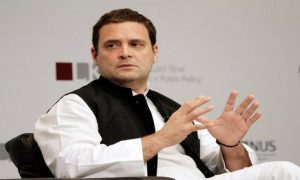The Kisan Kranti Yatra organised by the Bharat Kisan Union (BKU) was called off in the early hours on Wednesday, 3 October. Before that, the marching and agitating farmers had finally been allowed to cross the border at Ghaziabad and enter Delhi to end their rally at Kisan Ghat, their avowed objective.
Though a compromise appeared to have been reached, it has let more questions out of the bottle than it has stoppered. We should first note that this farmers’ rally was one in a long list of such demonstrations. There have been a number of massive rallies during the pendency of this regime: there was a massive demonstration in Maharashtra organised by the All India Kisan Sabha, demanding, inter alia, loan waivers, which the Devendra Fadnavis government was finally forced to concede; there have been strong exhibitions of unity in Madhya Pradesh, Rajasthan and Uttar Pradesh, the lattermost forcing the Yogi Adityanath government to announce a loan-waiver package; and there was the showpiece rally of farmers from all over the country ending at Jantar Mantar in Delhi in July 2017. The Maharashtra rally was held just a few months ago and succeeded in capturing the national imagination; many urban, middle-class people suddenly woke up to the issue of agrarian distress for the first time.
The 11 demands of the BKU-led Kisan Kranti Yatra encapsulated the demands of most farmers. Important among these were a remunerative minimum support price (MSP), loan waivers, a cut in fuel prices and power rates so that tractors and pumps could be operated at low cost and the implementation of the report of the Swaminathan commission, which was set up in 2004 under the renowned agronomist MS Swaminathan, the moving spirit behind the ‘Green Revolution’ in the late 1960s.
It has been reported that the government has acceded to ‘most’ of the demands, though there seems to be no public clarity on what has been acceded to and what has not. It has been suggested, though, that the demand for farm-loan waivers has been rejected, since it does not lie within the Centre’s sphere to grant it.
There is little doubt, if we are to begin with some basic background, that the agrarian sector is languishing and agrarian distress is on the rise. It has been suggested that over 2,000 farmers are quitting agriculture everyday. The growth rates in the agricultural sector are nothing to write home about either. A magazine, specialising in matters scientific and environmental, in a report says that while the 2004-14 period saw at 4 percent annually a golden run in the agricultural growth rate, it has plummeted since: it was – 0.20 percent in 2014-15; 2.10 percent in 2015-16; and 4.1 percent in 2016-17. This, despite two good monsoons.
The overall contribution of the agricultural sector to GDP was 18.30 percent in 2013-14, which fell to 17.40 in 2 015-16. Most of these statistics are taken from a report put together by the Dalwai committee, set up by the current government at the Centre in 2016 to find ways to double farm income by 2022. The suicide rate among farmers rose to 8,007 in 2015, up 41 percent from the 5,650 in 2014, according to statistics put out by the National Crime Records Bureau, although several ministers in various BJP governments attribute these suicides to reasons that have nothing to do with agrarian distress and the policies that has caused it.
It is in this context that we have to see the discrete elements that have pushed farmers from four corners of the country to converge in Bhopal, Delhi, Jaipur, Lucknow and Mumbai to demand their due. Let us begin with the issue of MSP.
Farmers have been demanding remunerative prices for their produce for decades. In times of scarcity and high prices, they are shortchanged of the profits they could have earned by middlemen; and in times of glut and low prices, they are often compelled to dump their produce either because it is uneconomic to take them to the market or to protest the lack of a viable MSP and robust procurement.
It was in this context that in the run-up to the 2014 elections, the then prime ministerial candidate Narendra Modi promised farmers they would get a much enhanced MSP – all costs covered and 50 percent above that. Unfortunately, like many of Modi’s fantastic promises, this one, too, has failed to materialise.
For four years, there was no action on this front. Neither did the MSP hike materialise, nor was the procurement arms of the government substantially strengthened. The Dalwai committee report says that in the past three years only 10-odd percent of farmers managed to sell their produce at MSP; in the past two years, 2015-17, farmers have had to sell bumper crops at 30-50 percent below the MSP.
Then there is the issue of the new MSP announced by Modi earlier this year. Agricultural scientists and agronomists point out that the new cost-plus-50 percent MSP is predicated on new criteria that excludes the cost of land, which used to be factored in earlier. According to the old formula, experts say, the hike effectively works out to just 13 percent for paddy. The attitude of the government was summed up by NITI Aayog vice-chairman Rajiv Kumar, who dismissed Swaminathan’s recommendation in respect of MSP by calling him an ‘impractical man’. Moreover, MSP covers only 6 percent of farmers, the rest are left to be buffeted by market forces.
The BJP government at the Centre is equally dismissive about the waiver of farm loans. The Centre has washed its hands of any financial commitment in this regard. Though Modi committed himself to the waiver of farm loans in 2017 – during the campaign for the Uttar Pradesh elections – the lack of central support has meant that cash-strapped states have been left holding the baby. A number of states have, in fact, signed up to waivers; some under duress. Andhra Pradesh, Karnataka, Maharashtra, Punjab, Tamil Nadu and Uttar Pradesh are some of the states that have announced waivers. The lack of support has meant, in some cases, surreal outcomes, with farmers being presented single-figure cheques.
The Swaminathan report is comprehensive, covering issues related to land reform, ecological sustainability, agricultural marketing, MSP, rural employment, investment in agriculture and lots more. Arguably, no government can implement its recommendation in its entirety ever, forget in four years, especially given the way India’s political economy plays itself out, but some things were easily achievable, like proper, rather than cosmetic, action on MSP, procurement (the government’s policies have failed to take off in this sphere as well), or investment in agriculture to create robust infrastructure. As for the last, what do we have?
The BJP government assumed power promising to double farm incomes. The Dalwai committee suggested an investment of Rs 6.4 lakh crore to meet the target but the 2018 budget for agriculture has been increased by just Rs 4,845 crore which severely exposes the promise as just rhetoric.
All told, Modi’s government has done practically nothing to address the concerns of distressed farmers. There was a time when farmers who hit the streets were usually small and marginal farmers, or the landless, but big, rich farmers – the kulaks – have also started hitting the streets. And this has sent the government into crisis-management mode.
Farmers are par excellence an ‘election issue’ and the BJP, if no other party, understands that in its marrow, now that it is no more mainly a ‘bania party’. Take the Jats, for example. In Western Uttar Pradesh, Haryana and parts of Rajasthan, the community voted solidly for the party, enabling it to blank out the Congress in Rajasthan and get 7 out of 10 seats in Haryana, as well as 71 out of 80 in Uttar Pradesh.
But the Jats are now disenchanted. It must be a fair conjecture that many of those trying to march into Delhi on 2 October, were from that community. Then, of course, there was the massive and violent stir in Haryana based on the demand that they should be listed as other backward castes, which, again, possibly stemmed from the fact that their main occupations – farming and dairying – had been badly hit. Similar is the case with the once prosperous Patidar community of Gujarat, who are, or were, prosperous farmers.
Somewhere in the labyrinthine, number-crunching personal bureaucracy that supports the Modi dispensation, ably propped up by party president Amit Shah, the realisation must be dawning that a disaffected farm sector does not bode well for the BJP’s electoral prospects. This is even more so because two surreal initiatives undertaken, or underwritten, by the Modi-Shah act have massively exacerbated the agrarian crisis.
One is demonetisation, which coming, as it did, bang in the middle of the kharif marketting season sent an already reeling sector into an irreversible tailspin. Second, was the spate of draconian amendments to anti-cow slaughter legislation, followed by widespread incidents of ‘beef vigilantism’, which sent the bovine economy into a similar tailspin. Since the two economies must feed off each other for both to be prosperous, this double blow caused a grievous injury.
The question now is: Can the BJP retrieve the situation? The combination of Modi’s Teflon charisma and Shah’s incredible ability to pursue detail has been endowed by now with near-mythical powers, but, with the public mood bordering on the sullen, even the ruling deities of the ruling dispensation could find it difficult to extricate the party from the farming mess.
For more updates: Like us on Facebook and follow us on Twitter & Instagram




































